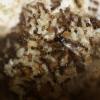I've heard it said that Camponotus prefers drier nests. Would it then make sense that drier species would prefer a test tube setup with less humidity? How could that be achieved?
At first glance, a narrower test tube would seem to help since it reduces the surface area of the wet cotton. However, the surface area of the wet cotton remains roughly proportional to size of the air chamber that the wet cotton is humidifying and also to the cotton at the entrace which presumably reduces the humidity. So that won't work.
Then I thought that using longer test-tubes/air-chambers might help to control humidity. I suspect that providing longer air chambers would create a wider humidity gradient because there would presumably be less air traffic between the air at the entrance and the air at the wet cotton and so the rear of the air chamber would tend to be humid while the front was dry. But if queens always huddle towards the deepest place in the test tube, then having a gradient is of no help at all.
After yet more consideration, the best way to control the test tube's humidity might be to adjust the amount of cotton at the entrance. The more cotton, the more air that's trapped against the wet cotton. However, you can only make the entrance so narrow before there's an escape.
Maybe the lack of attention to humidity in test tube setups might explain when some losses.
If it truly is worth designing dryer formicariums for drier species, then the test tube setup would seem to deserve the same attention. Do you agree? Or is the humidity preferences between species mostly ignored because we simply provide a gradient. Still, I would think that you would want the optimal gradient for your species, since ignoring this preference could potentially make some of your formicariums barely tolerable to your ants.
I'm mostly just thinking out loud here and wondering what you folks think.
- Formiculture.com
- Forums
- Gallery
- Members
- Member Map
- Chat














